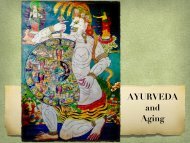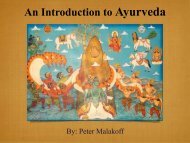How Thoreau's Walden Pond Mixed with the Ganges and Yoga Came to America with Swami Vivekananda
One early morning in 1846, during the coldest days of a New England winter, Henry David Thoreau looked out the window of his small cabin on Walden Pond and saw men cutting its ice into blocks. That ice was hauled by horse to a railroad that ran across the western edge of Walden Pond, packed into a boxcar, taken to Boston and loaded onto a clipper ship that sailed to Calcutta, India, arriving about four months later. Once there, that ice was purchased by grateful members of the East India Company. Thoreau had witnessed a small part of the global ice trade between New England and India that took place during the latter part of the nineteenth century. When Thoreau considered the ice trade, his vision sailed on metaphors far beyond the scope of business. The waters he imagined flowed both east and west and carried not just natural elements, but culture, religion and philosophy as well. He envisioned that after arriving in Calcutta, the New England ice of Walden Pond would eventually melt and run downhill where it would join with the sacred water of the Ganges. He wrote in Walden: "It appears that the sweltering inhabitants of Charleston and New Orleans, of Madras and Bombay and , drink at my well. In the morning I bathe my intellect in the stupendous and cosmogonal philosophy of the , since whose composition years of the gods have elapsed, and in comparison with which our modern world and its literature seem puny and trivial; and I doubt if that philosophy is not to be referred to a previous state of existence, so remote is its sublimity from our conceptions. I lay down the book [Bhagavad-Gita] and go to my well for water, and lo! there I meet the servant of the Bramin, priest of and and who still sits in his temple on the Ganges reading the , or dwells at the root of a tree with his crust and water jug. I meet his servant come to draw water for his master, and our buckets as it were grate together in the same well. The pure Walden water is mingled with the sacred water of the Ganges." This book tells the story of these waters . . .
One early morning in 1846, during the coldest days of a New England winter, Henry David Thoreau looked out the window of his small cabin on Walden Pond and saw men cutting its ice into blocks. That ice was hauled by horse to a railroad that ran across the western edge of Walden Pond, packed into a boxcar, taken to Boston and loaded onto a clipper ship that sailed to Calcutta, India, arriving about four months later. Once there, that ice was purchased by grateful members of the East India Company. Thoreau had witnessed a small part of the global ice trade between New England and India that took place during the latter part of the nineteenth century.
When Thoreau considered the ice trade, his vision sailed on metaphors far beyond the scope of business. The waters he imagined flowed both east and west and carried not just natural elements, but culture, religion and philosophy as well. He envisioned that after arriving in Calcutta, the New England ice of Walden Pond would eventually melt and run downhill where it would join with the sacred water of the Ganges. He wrote in Walden: "It appears that the sweltering inhabitants of Charleston and New Orleans, of Madras and Bombay and , drink at my well. In the morning I bathe my intellect in the stupendous and cosmogonal philosophy of the , since whose composition years of the gods have elapsed, and in comparison with which our modern world and its literature seem puny and trivial; and I doubt if that philosophy is not to be referred to a previous state of existence, so remote is its sublimity from our conceptions.
I lay down the book [Bhagavad-Gita] and go to my well for water, and lo! there I meet the servant of the Bramin, priest of and and who still sits in his temple on the Ganges reading the , or dwells at the root of a tree with his crust and water jug. I meet his servant come to draw water for his master, and our buckets as it were grate together in the same well. The pure Walden water is mingled with the sacred water of the Ganges."
This book tells the story of these waters . . .
You also want an ePaper? Increase the reach of your titles
YUMPU automatically turns print PDFs into web optimized ePapers that Google loves.
Brahmin<br />
“According <strong>to</strong> ancient Indian<br />
philosophers <strong>and</strong> scholars, <strong>the</strong><br />
human society comprises four<br />
pillars or classes called varnas<br />
or colors. In <strong>the</strong> ancient Indian<br />
texts such as <strong>the</strong> Smritis, vedas,<br />
upanishads, puranas, etc.,<br />
<strong>the</strong>se four "varnas" or classes<br />
or pillars of <strong>the</strong> society are: <strong>the</strong><br />
priests / Acharya (Brahmins),<br />
<strong>the</strong> rulers <strong>and</strong> military (Kshatriyas),<br />
<strong>the</strong> merchants <strong>and</strong> agriculturists(Vaishyas),<br />
<strong>and</strong> <strong>the</strong> Assistants (Shudras). Brahmin priests / Acharya were<br />
engaged in attaining <strong>the</strong> highest spiritual knowledge (brahmavidya) of Brahman<br />
(God) <strong>and</strong> followed different branches (shakhas) of Vedas. A Brahmin priest is responsible<br />
for religious rituals in temples <strong>and</strong> homes of Hindus <strong>and</strong> is authorized<br />
only after rigorous training in vedas <strong>and</strong> sacred rituals, as a liaison between humans<br />
<strong>and</strong> <strong>the</strong> God. In general, as family vocations <strong>and</strong> businesses are inherited,<br />
priesthood used <strong>to</strong> be inherited among Brahmin priest families, as it requires<br />
years of practice of vedas from childhood after proper introduction <strong>to</strong> student<br />
life through a religious initiation called upanayana at <strong>the</strong> age of about five.<br />
The Brahmin priest has <strong>to</strong> wake up at four in <strong>the</strong> morning <strong>and</strong> ba<strong>the</strong> in cold<br />
water, rain or shine, warm or cold. Then, <strong>with</strong>out a break, he has <strong>to</strong> perform<br />
one rite after ano<strong>the</strong>r: s<strong>and</strong>hyav<strong>and</strong>ana, brahmayajna, aupasana, puja, vaisvadeva<br />
<strong>and</strong> at least one of <strong>the</strong> 21 sacrifices for hours, in front of a sacred fire,<br />
<strong>with</strong> all <strong>the</strong> heat <strong>and</strong> smoke. So many are <strong>the</strong> vows <strong>and</strong> <strong>the</strong> fasts <strong>the</strong> priest must<br />
keep, <strong>and</strong> as many are <strong>the</strong> ritual baths <strong>the</strong> priest must take in a day. The dharmasastras<br />
require that <strong>the</strong> Brahmin priest adheres <strong>to</strong> <strong>the</strong> rules <strong>and</strong> rituals imposed<br />
on <strong>the</strong> priest not only during <strong>the</strong> performance of <strong>the</strong> many rites <strong>and</strong> rigorous<br />
discipline, but also every second of his life, because <strong>the</strong> Brahmin priest life is<br />
dedicated <strong>to</strong> God.<br />
The priest performing rituals, may have his first meal at 1 or 2 PM (<strong>and</strong> on<br />
<strong>the</strong> day of a sraddha (cremation) it will be three or four PM. The Brahmin<br />
priest's vegetarian meal <strong>and</strong> dwelling are simple <strong>and</strong> humble. Brahmin (or Brahmana)<br />
refers <strong>to</strong> an individual belonging <strong>to</strong> <strong>the</strong> Hindu priest, artists, teachers,<br />
technicians class (varna or pillar of <strong>the</strong> society) <strong>and</strong> also <strong>to</strong> an individual belonging<br />
<strong>to</strong> <strong>the</strong> Brahmin tribe/caste in<strong>to</strong> which an individual is born; while <strong>the</strong> word<br />
Brahma refers <strong>to</strong> <strong>the</strong> creative aspect of <strong>the</strong> universal consciousness or God. The<br />
English word brahmin is an anglicized form of <strong>the</strong> Sanskrit word Brāhmana.”<br />
– Wikipedia, The Free Encyclopedia<br />
Related Glossary Terms<br />
Brahma, Brahmin pundit, Upanishads, Vedas


















